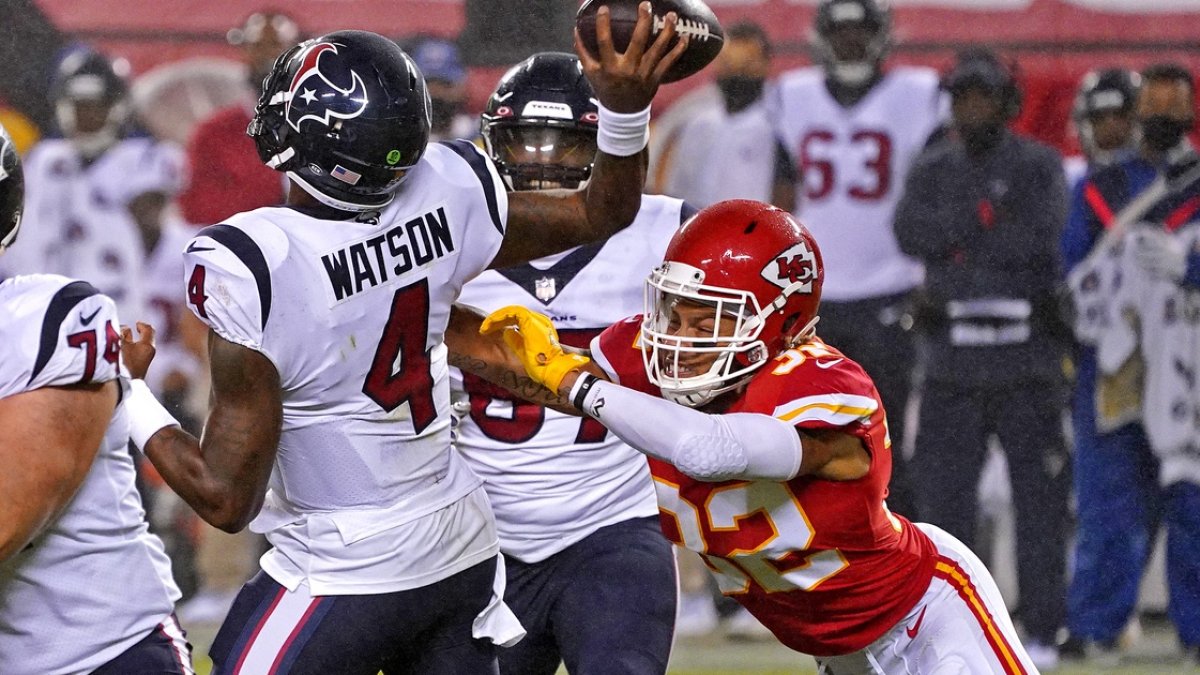All of the headlines surrounding the Houston Texans this offseason were focused on the skill position players.
With the massive extension given to quarterback Deshaun Watson and the shift in offense that came with trading away elite wide receiver DeAndre Hopkins, the focus was always going to be on those areas. But the team's opening night loss at the hands of the Kansas City Chiefs raised the question of whether this team's season will be determined in the trenches.
Part of Houston's team-building strategy has certainly involved the offensive line. They traded two first-round picks plus a second-rounder to the Miami Dolphins in exchange for left tackle Laremy Tunsil, and then made him the best-paid tackle in the game. They left themselves short-handed with draft picks but fired shots in each of the last three drafts, taking an offensive lineman with at least one of their first three picks each of those drafts. It isn't like the team has neglected the offensive line, but Thursday night, we saw evidence that it has yet to work.
Pressure was one of the big differences between the two sides. While Patrick Mahomes was hurried on just six of 33 dropbacks (18.2%) — fully half of which he was a part of bringing on himself — Watson was under fire on 35% of his dropbacks. What's even more concerning is that it wasn't just because of one weak link along the line — every member of the Texans offensive line surrendered multiple pressures, and Watson didn't help matters when things did begin to break down.
Houston's offensive linemen weren't just losing; they were losing decisively. There were six pressure plays where heat was applied on Watson in under 2 seconds, a timeframe that is virtually impossible for the quarterback to function within.
Houston Texans offensive line: Pass-blocking grades and pressures allowed versus the Kansas City Chiefs
| Position | Player | Pass-blocking snaps | Pressures allowed | PFF pass-blocking grade |
| LT | Laremy Tunsil | 41 | 2 | 75.6 |
| LG | Max Scharping | 41 | 2 | 54.4 |
| C | Nick Martin | 41 | 2 | 54.8 |
| RG | Zach Fulton | 41 | 2 | 50.1 |
| RT | Tytus Howard | 41 | 3 | 49.0 |
There has been significant speculation this offseason, including from me, that losing a player like Hopkins could actually force Watson to become a better fundamental quarterback, removing his crutch and requiring him to read the game more honestly to find the most open receiver on any given play. If that is going to happen, it's either going to take some time or the Texans need to face some teams less capable than the Chiefs at applying pressure. But given that their next three opponents are the Ravens, Steelers and Vikings, that second part is unlikely to happen any time soon.
Much of Watson's greatness comes from crazy plays outside of structure after pressure has been put on him, but leaning into that stylistically is a very small needle to thread. Against Kansas City, Watson averaged 3.14 seconds with the ball in his hands, almost a full second longer than Mahomes per play.
As mentioned earlier, a third of the pressure came so fast that no amount of speeding up his process would have mitigated the danger, but the other two-thirds could have been affected if Watson had speeded up his game.
Play under pressure can be spectacular, but it is also highly unstable and unpredictable. And over a long period of time, virtually no quarterback plays well in the face of it. The only two quarterbacks with a PFF grade above 70.0 when under pressure over the past two seasons are Mahomes and Drew Brees; that grade of 70.0 would only have been good enough to rank 21st overall in 2019. Watson has been some way below that at 54.6 when pressured.
Over the past two seasons, PFF has charged Watson with 26 sacks independent of the blocking that has been protecting him. That is among the worst rates in the NFL, and it is an issue that he needs to improve if he is to be working in harmony with the rest of the offense rather than fighting against it.
Though those spectacular plays under pressure are part of what makes Watson great, reaching his true potential lies in minimizing how often he needs to make them and leaning into the situations where his life is easier — throws within structure and before pressure arrives.
The Texans offensive line is likely to be a work in progress, but it was supposed to be the best line that has been put in front of Watson so far in his NFL career. For that to have any chance of proving true, Watson needs to do his part and protect his protection. As PFF has shown before, quarterbacks own their pressure rate to a huge degree. Improving the level of pass-protectors in front of Watson will make a big difference to his play, but the biggest difference that can be made comes from an adjustment to his game, one that likely needs to be made without Hopkins anyway.
Though life after Hopkins has thrust all of the attention on Watson and the skill position players — including newly rejuvenated David Johnson in the backfield — it may be the offensive line and pass protection that determines how good this team can be. And nothing affects that dynamic more than Watson's play behind them.



 © 2025 PFF - all rights reserved.
© 2025 PFF - all rights reserved.